Source: The Conversation (Au and NZ) – By Adele Jackson, Adjunct Researcher, College of Arts, Law and Education, University of Tasmania
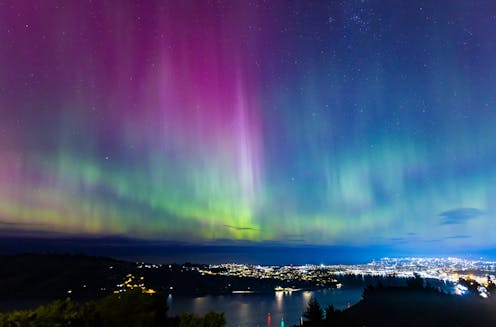
Social media has once again lit up with the spectacle of aurora australis, also known as the Southern Lights, as it became visible in some skies across the southern states last night.
The lights – which aren’t seen outside the south polar region very often – were last sighted in May, unusually far north in the skies of Australia, New Zealand, South America and South Africa.
Despite (or maybe because of) their infrequent appearance, the Southern Lights have long inspired humans. From as far back as early Aboriginal ancestral accounts, to recent contemporary art, they have continued to ignite our imagination. Let’s take a look at some examples.
Visual works
1. Pavel Mikhailov
Pavel Mikhailov (1787–1840) was a Russian expedition artist with the Imperial Russian Navy’s first Antarctic expedition, which sailed from 1819 to 1821.
Captained by Fabian Bellingshausen, the voyage circumnavigated the south polar seas in search of the fabled “southern continent” which Captain James Cook had hoped to find some 50 years earlier.
In 1820, Bellingshausen’s became one of three expeditions to glimpse the edges of the continent (the others were headed by Irish-British explorer Edward Bransfield and US explorer Nathaniel Palmer).
Although there are much earlier accounts of aurora australis, Mikhailov’s watercolour – reproduced from a sketch he drew on March 2 1820, is one of the first painted depictions to come straight from Antarctic waters.
The expedition’s astronomer noted in his diary:
I saw three shining pillars […] the colour of a comet’s tail. Long did I gaze at that aurora.
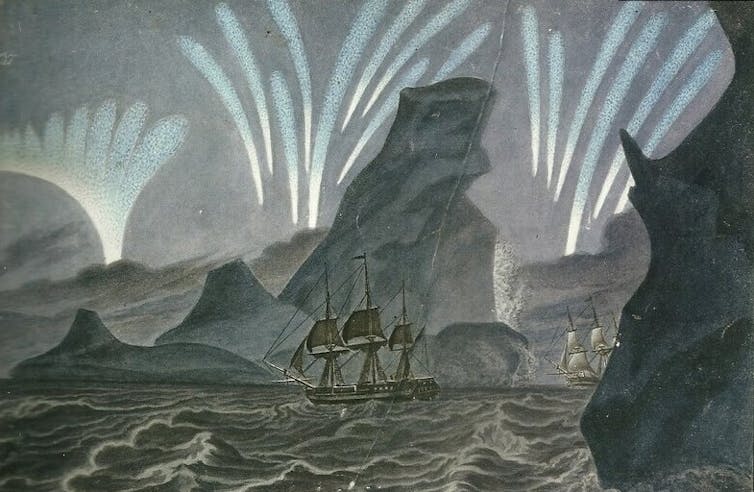
State Russian Museum
2. Edward Roper
Painter and printer Edward Roper (1854–1909) was born in the United Kingdom and lived between the UK, Canada and Australia in the late 19th century.
His 1870 portrayal of an aurora seen from Port Phillip, Melbourne, shares a striking resemblance to Mikhailov’s painting (albeit minus the icebergs). The red tinge in the rays of light indicates Roper’s lower-latitude viewpoint.
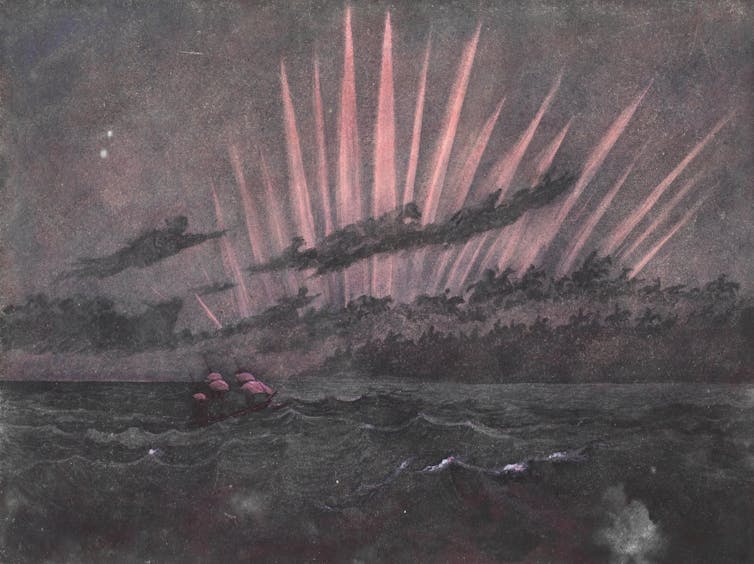
Bonhams
3. Edward Wilson
Edward Adrian Wilson (1872–1912) was a naturalist, physician and expedition artist with both of British Captain Robert Falcon Scott’s Antarctic expeditions, Discovery (1901–04) and Terra Nova (1910–13). Throughout these, Wilson faithfully recorded Antarctica’s landscapes, wildlife and atmospheric phenomena for the benefit of science.
His white-on-black chalk sketches of south polar aurorae emphasise the shape of the various formations as seen in the winter of 1902. He meticulously recorded the date, time and a descriptive title with each of his drawings.
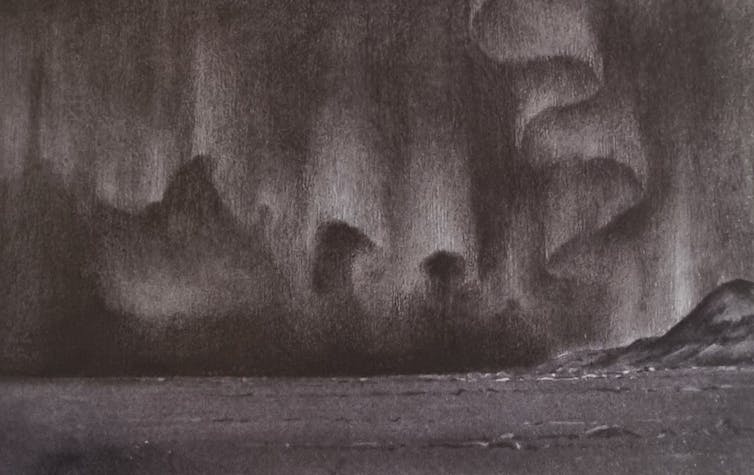
Scott Polar Research Institute collection, accession no. N: 1803/151
4. George Marston
George Edward Marston (1882–1940) was the expedition artist for famous explorer Ernest Shackleton’s Nimrod (1907–09) and Imperial Trans-Antarctic (1914–17) expeditions.
In 1908, during his first Antarctic winter, Marston used oil paints to capture the aurora australis. In his atmospheric scene the air is still, the night is clear and sled dogs frolic in the snow under the blue/green glow of the moonlight and the aurora. The Cape Royds expedition hut (now a protected historic site) blends into the hillside while three men brave the cold to watch the lights perform over Mount Erebus.
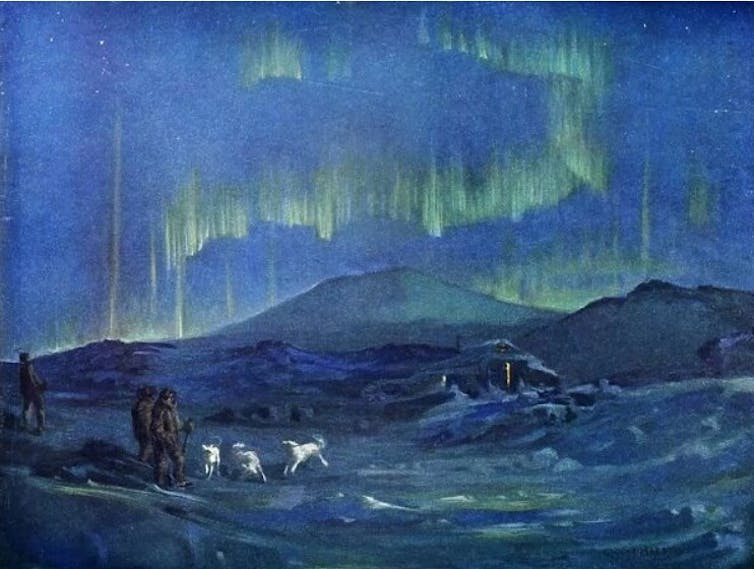
Christies
5. George Marston
Worthy of a second mention, Marston produced the images for “Aurora Australis”, the first book to be written, printed and published in Antarctica. Copies are highly prized, as fewer than 100 were lovingly hand-printed during the dark and frigid winter months of 1908. The title page features Marston’s lithographic print of the aurora australis dancing above Mount Erebus, the southernmost active volcano.
6. David Abbey-Paige
David Abbey-Paige (1901–1978) was the official expedition artist with Admiral Richard Evelyn Byrd’s second Antarctic expedition (1933–1935). The artist worked almost exclusively in pastels in Antarctica to avoid the issue of freezing paints. His drawings are a celebration of polar light and colour.
In one drawing, a lone emperor penguin stands in an icescape illuminated by a stream of green auroral light.
7. Stephen Eastaugh
Stephen Eastaugh is an Australian itinerant artist who has travelled to Antarctica nine times, including three times with the Australian Antarctic Division (AAD). He is the only AAD arts fellow to have over-wintered.
He created his Outlandish – Aurora Australis series during a winter at Mawson Station in 2009. Each panel in this work has an icy feature in the foreground and a black polar night backdrop, upon which Eastaugh has stitched astonishing green aurorae, streaming and unfurling playfully across the sky.
8. Bill Sutton
The late William Alexander “Bill” Sutton (1917–2000) was one of New Zealand’s most respected 20th-century landscape painters.
His work Aurora at Arrowtown (1949), painted early in his career, contrasts with his later expansive mountain scenes and abstracted landscapes. The greyed Arrowtown buildings are barely visible in the gloomy half-light. Like a portent of doom, a glowing blood-red aurora looms ominously over the town.
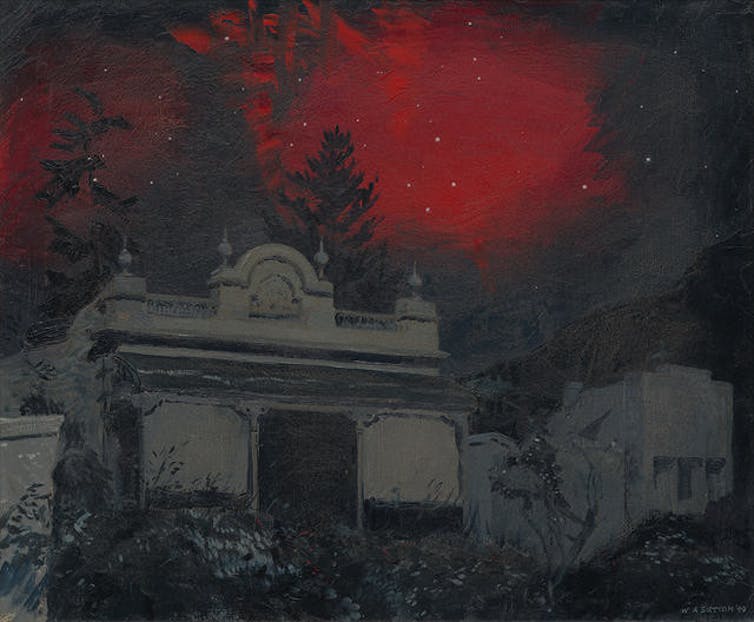
Christchurch Art Gallery
Multimodal works
9. David Haines and Joyce Hinterding
David Haines and Joyce Hinterding – two contemporary artists based in Sydney’s Blue Mountains – brought the energy of the solar and electromagnetic realms into the art gallery in their 2008 multi-sensory installation EarthStar.
The artwork combined sight, sound and smell. A video projection of the Sun’s surface, recorded through a hydrogen-alpha telescope lens, showed the detail of the Sun’s corona and the ejections of material that can cause auroral activity. Copper-coiled antennas tuned to detect electromagnetic activity were hooked up to amplifiers that emitted audible pops and sizzles of invisible energy.
To complete the “triptych”, Haines created a synthetic aroma in liquid form that represented the smell of burning ions in an aurora. As Haines explained, “If one could go up into the Earth’s ionosphere when an aurora takes place it would probably smell like this due to burning of oxygen molecules.”
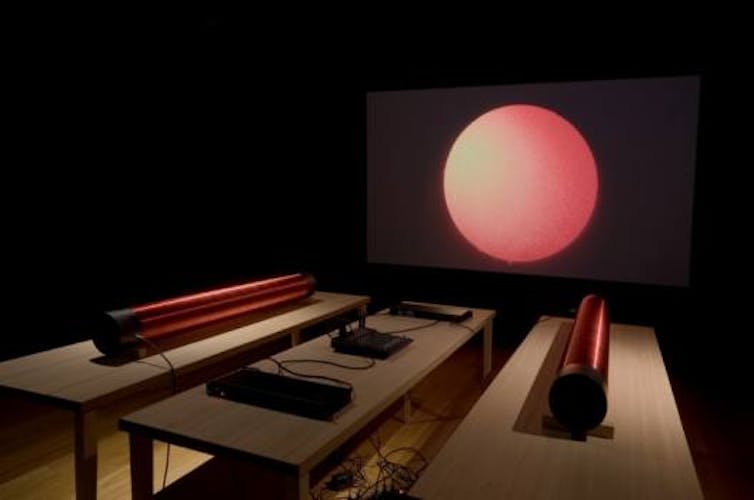
Courtesy of the artists
10. Jason O’Hara and Warren Maxwell
Jason O’Hara is a digital storyteller, photographer and experience designer based in Wellington, New Zealand. Along with Auckland-based musician and composer Warren Maxwell, the pair created the immersive 2019 work Where Memories Sleep: The Legend of the Aurora.
O’Hara and Maxwell travelled south with Antarctica New Zealand, the government agency responsible for supporting the country’s Antarctic research program. These journeys inspired their spectacular cine-dance production which combines music, dance and cinematography.
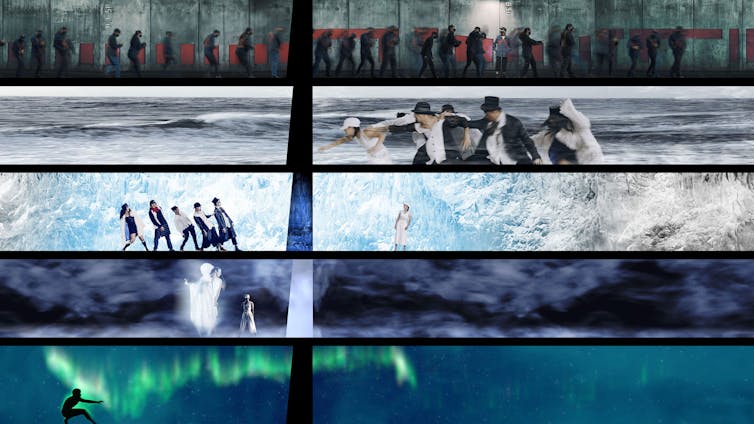
Jason O’ Hara
The story follows a young explorer who ventures to the ice, where she meets a powerful kuia (female Māori elder), who gifts her the memories of the world (a metaphor for scientific research into Earth’s geological and climate pasts).
She falls in love with a selkie, a seal-human shapeshifter. In the closing scene, when she has to return home, the selkie’s love song transcends from the ocean to the sky, transforming into the aurora australis – beckoning his love back to Antarctica.
![]()
Adele Jackson does not work for, consult, own shares in or receive funding from any company or organisation that would benefit from this article, and has disclosed no relevant affiliations beyond their academic appointment.
– ref. 10 times the aurora australis inspired remarkable works of art – https://theconversation.com/10-times-the-aurora-australis-inspired-remarkable-works-of-art-228629







